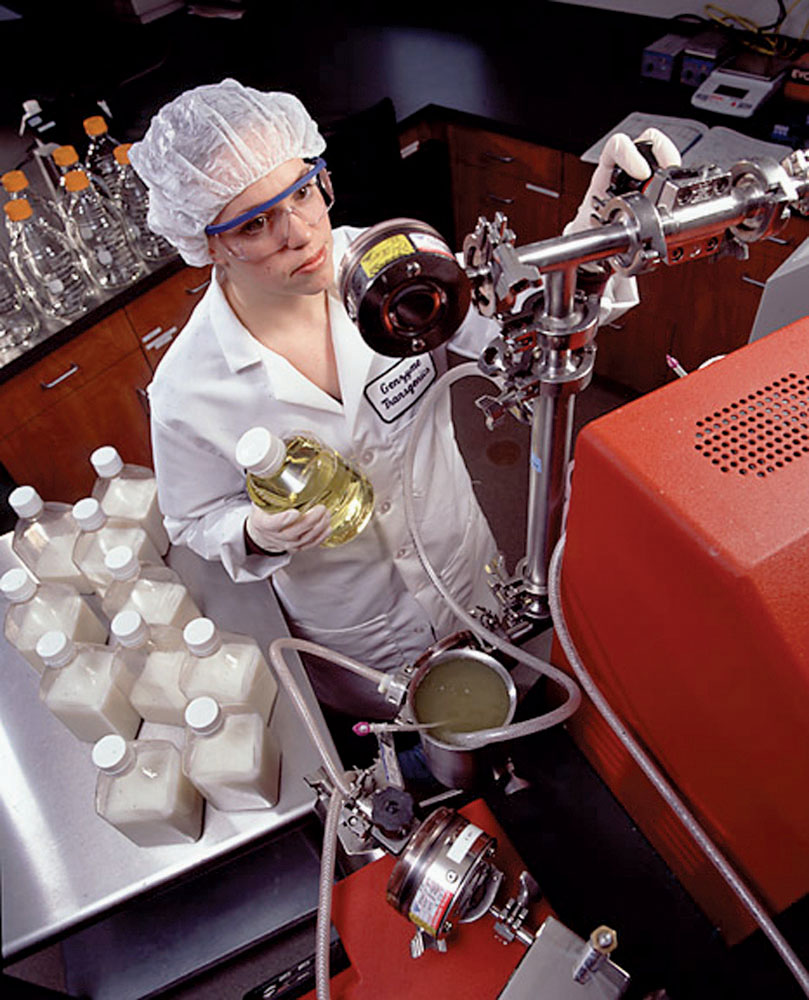THE ADVANTAGES OF “PHARMING”
While Meade’s goats are currently the talk of the barnyard, this is actually not the first time that living organisms have been used to make drugs to treat humans. Before the era of genetic engineering, medicinally useful proteins were routinely obtained and purified from animal organs or blood. Insulin, for example, which is used to treat diabetes, was originally extracted from pig pancreas. Since the early 1980s, with the rise of genetic engineering, scientists have used bacteria to make recombinant human proteins, including insulin. The problem with this method is that bacteria can make only very simple human proteins. More-complex human proteins, such as antithrombin, require mammalian cells to produce them. For that reason, beginning in the 1990s scientists began using hamster cells grown in culture to make protein drugs. Many currently available biotech drugs, including the cancer drug Avastin and the rheumatoid arthritis drug Humira, are produced by this method.

But even hamster cells grown in culture have limitations. To produce protein drugs from hamster cells, scientists must grow the cells in giant stainless steel vats, which cost millions of dollars to purchase and maintain. The cells secrete proteins into the culture medium, and the proteins are then extracted and purified from this liquid. But typically only very small amounts of protein are obtained this way, so the cost per unit of drug can be quite pricey–thousands of dollars per gram, $50,000–$100,000 per treatment.
As an example, Meade points to the human protein drug factor VII. This protein helps blood clot. Males with the genetic disease hemophilia, a sex-linked trait that is passed from mothers to their sons (see Chapter 12), are born with clotting factor alleles that either encode nonfunctional clotting factor protein or no clotting factor protein at all. Consequently, if a hemophiliac cuts himself, he must be quickly transfused with clotting factor or he may bleed to death. Doctors usually give patients factor VII protein to restore normal coagulation and prevent excessive bleeding.
Companies that sell factor VII produce it by cell culture. But the drug is extremely expensive: 1 mg of factor VII can cost up to $1,000. At the recommended dose of 90 g/kg (micrograms per kilogram of body weight) given every 2–3 hours to a patient with hemophilia, that’s easily $50,000 per day. Transgenic goats, by contrast, can produce human clotting factors in their milk in large volumes for about one tenth of the cost.
178
The mammary gland is a “natural bioreactor,” rEVO scientists like to say. Moreover, it’s a bioreactor that lives on inexpensive hay and can be milked twice a day for 7 years. And scaling up is easy. “If I own a giant factory and I want to double capacity, I have to build another factory with all of the industrial issues that that brings,” explains Lowry, of rEVO. With goats, however, “If you want to double your capacity, all you have to do is allow boy and girl goats to do what they do.”
How do recombinant proteins stack up against ones produced naturally by the body? ATryn has the same amino acid sequence as natural antithrombin, and clinical trials have shown it to have similar efficacy as antithrombin isolated from human donors, with only minor dosing differences. “Clinically, they’re equally efficacious in accomplishing the prevention of blood clotting,” says physician Paidas, of Yale. It’s also cheaper: the wholesale price of ATryn is approximately $4,000 per vial; the equivalent amount of human-derived antithrombin costs about $5,600.
ATryn is currently only FDA-approved to treat patients with inherited antithrombin deficiency, but as of 2013 researchers were beginning clinical trials of the drug as a treatment for preeclampsia-a life-threatening condition that affects a substantial number of pregnant women and their babies every year.
In addition to ATryn, rEVO is currently working on establishing transgenic animals to produce VII and other clotting proteins, as well as a number of other important drugs, including antibodies to treat cancer.
“We have the potential to build an abundant and controlled supply for any plasma protein,” says Thomas Newberry, a company spokesperson, who predicts that protein drugs extracted from human blood may become a thing of the past. “In the future, I won’t be surprised if people start to think that reinjecting blood products into other people is barbaric.”